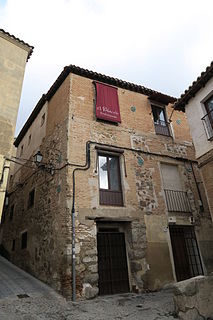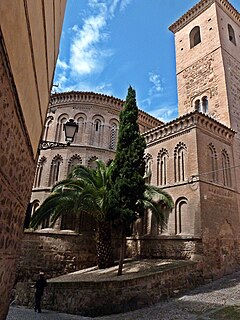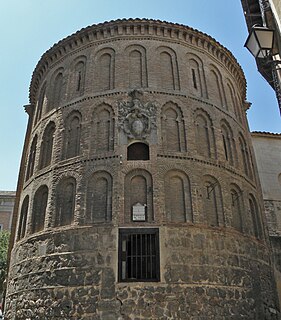
Toledo is a province of central Spain, in the western part of the autonomous community of Castile–La Mancha. It is bordered by the provinces of Madrid, Cuenca, Ciudad Real, Badajoz, Cáceres, and Ávila. Its capital is the city of Toledo.

The Samanid Mausoleum is a mausoleum located in the northwestern part of Bukhara, Uzbekistan, just outside its historic center. It was built in the 10th century CE as the resting place of the powerful and influential Islamic Samanid dynasty that ruled the Samanid Empire from approximately 900 to 1000. It contained three burials, one of whom is known to have been that of Nasr II.

The Mosque of Cristo de la Luz is a Catholic chapel and former mosque in Toledo, Spain. It is the one of the ten that existed in the city during the Moorish period. The edifice was then known as Mezquita Bab-al-Mardum, deriving its name from the city gate Bab al-Mardum. It is located near the Puerta del Sol, in an area of the city once called Medina where wealthy Muslims used to live.

Nasseef House or Nassif House is a historical structure in Al-Balad, Jeddah, Saudi Arabia. As of 2009, it is a museum and cultural center which has special exhibits and lectures given by historians.
Santa María de Melque is a church in the province of Toledo in Spain. It has been described as the biggest fully vaulted early medieval church still standing in Western Europe. It is located in the municipality of San Martín de Montalbán, equidistant from the towns of La Puebla de Montalbán and Gálvez, between the brook Ripas and the river Torcón, a tributary of the river Tagus.

The Colegio de Doncellas Nobles is a former girls' school in Toledo. It was founded in 1551 by the archbishop of Toledo and cardinal Juan Martínez Silíceo. The project, which had as its patron the king Philip II as well as the archbishop, had as its object the education of young women to be good mothers. Some came from humble families and others from noble families from all over Europe. They were expected to be of "clean blood". Funding was provided for the dowries of former pupils.

The Mezquita de las Tornerías is a Moorish former mosque in Toledo. It was built in the middle of the 11th century on the foundations of Roman architecture, located in the old Muslim neighborhood Arrabal de Francos. Currently it houses the "Center Foundation of Promotion of the Crafts", that can be visited and hosts temporary exhibitions.

The Iglesia de El Salvador is a church in Toledo, Spain completed in 1159.

Tianjin CTF Finance Center is a super-tall skyscraper located in the TEDA CBD of Binhai, Tianjin, China. Construction started in 2013 and was completed in 2019. The tower is the second tallest building in Municipal Tianjin after Goldin Finance 117, eighth tallest building in the world, and the tallest building in the world with fewer than 100 floors. It is located in the outer district of the Tianjin Economic-Technological Development Area. Tianjin CTF Finance Center is designed by Skidmore, Owings & Merrill LLP in collaboration with Ronald Lu & Partners.

The Palacio Arzobispal de Toledo or Archbishop's Palace of Toledo is a palace located in front of the Cathedral and next to the City Hall in the city of Toledo, region of Castile-La Mancha, Spain.

The Cave of Hercules is a subterranean vaulted space dating back to Roman times located in the alley of San Ginés in the city of Toledo, Spain. The cave is under a building located where the Church of San Ginés, Toledo stood until 1841.

The Convento de San Juan de la Penitencia, also known as the Colegio de Doncellas pobres de San Juan de la Penitencia, is an Isabelline former convent building that was erected in 1514 in Toledo, Spain.

The Templar House in Toledo, in Castile-La Mancha, Spain, was built and decorated between the years 1085 and 1114, belonging to this period the general structure, typically Al-Andalusian, supported by the vaults of the basement and organized around the courtyard. The strict contemporaneousness existing between this monument of Toledo, the Aljafería palace of Zaragoza (1046–1082), and the roofing of the church of San Millán of Segovia is shown by the fact that the large majority of the construction elements for the roofs and ornamental designs are practically the same on all three buildings.

The Church of San Bartolomé is a medieval building in Toledo, in Castile-La Mancha, Spain. It is located in the southern part of the walled city, at the corner of calle San Bartolomé and calle Cristo de la Para, a few hundred meters south-west of the Cathedral of Santa María.

The Iglesia de San Vicente is a medieval church located in Toledo, it appears as a parish already in 1125, although, there is documentation that speaks of its being founded by Alfonso VI shortly after his conquest of the city in 1085.

The Colegio de Nuestra Señora de los Infantes is a school in the city of Toledo. It was founded in the 16th century by Juan Martínez Silíceo, Archbishop of Toledo and later a cardinal, and was intended to provide a specialist musical education for the cathedral's young singers.

The Convento de la Madre de Dios is a Dominican convent located in the city of Toledo. It was founded at the end of the 15th century as a nunnery by Leonor and María de Silva, daughters of the Count of Cifuentes. It was a cloistered monastery, a Guardia Civil barracks, and finally a university campus after its acquisition by the University of Castilla-La Mancha to expand the facilities of the Faculty of Juridical and Social Sciences.

The Convento de la Purísima Concepción, also called Convento de Capuchinas, is a convent located in the city of Toledo, in Castile-La Mancha, Spain.
The Plaza de San Justo is a square located in the city of Toledo, in Castile-La Mancha, Spain. In the upper part of the city, halfway between the Alcázar and the Cathedral there is a square named after the Church of San Justo y Pastor. Of the same church and in that same square it says the legend of "The Christ of the Cutlery". There a sign where it read the legend where events are supposed to happen, or not.

The Palacio del Marqués de Malpica is a building in the city of Toledo, Castile-La Mancha, Spain. It's located at the Plaza de Santa Clara and next to the monastery of the same name. It is of Renaissance style and belonged to the Marquis of Malpica y Valdepusa.




















